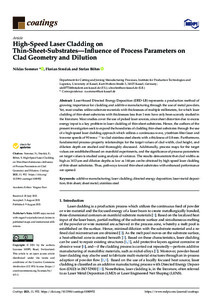| dc.date.accessioned | 2021-10-20T11:57:18Z | |
| dc.date.available | 2021-10-20T11:57:18Z | |
| dc.date.issued | 2021-08-09 | |
| dc.identifier | doi:10.17170/kobra-202110114876 | |
| dc.identifier.uri | http://hdl.handle.net/123456789/13308 | |
| dc.description.sponsorship | Gefördert durch den Publikationsfonds der Universität Kassel | ger |
| dc.language.iso | eng | eng |
| dc.rights | Namensnennung 4.0 International | * |
| dc.rights.uri | http://creativecommons.org/licenses/by/4.0/ | * |
| dc.subject | additive manufacturing | eng |
| dc.subject | laser cladding | eng |
| dc.subject | directed energy deposition | eng |
| dc.subject | laser metal deposition | eng |
| dc.subject | thin sheet | eng |
| dc.subject | sheet metal | eng |
| dc.subject | stainless steel | eng |
| dc.subject.ddc | 620 | |
| dc.subject.ddc | 660 | |
| dc.title | High-Speed Laser Cladding on Thin-Sheet-Substrates—Influence of Process Parameters on Clad Geometry and Dilution | eng |
| dc.type | Aufsatz | |
| dcterms.abstract | Laser-based Directed Energy Deposition (DED-LB) represents a production method of growing importance for cladding and additive manufacturing through the use of metal powders. Yet, most studies utilize substrate materials with thicknesses of multiple millimeters, for which laser cladding of thin-sheet substrates with thicknesses less than 1 mm have only been scarcely studied in the literature. Most studies cover the use of pulsed laser sources, since sheet distortion due to excess energy input is a key problem in laser cladding of thin-sheet substrates. Hence, the authors of the present investigation seek to expand the boundaries of cladding thin-sheet substrates through the use of a high-speed laser cladding approach which utilizes a continuous-wave, ytterbium fiber laser and traverse speeds of 90 mms−1 to clad stainless steel sheets with a thickness of 0.8mm. Furthermore, fundamental process–property relationships for the target values of clad width, clad height, and dilution depth are studied and thoroughly discussed. Additionally, process maps for the target values are established based on manifold experiments, and the significance of process parameters on target values is studied using analysis of variance. The results demonstrate that clad widths as high as 1413 μm and dilution depths as low as 144 μm can be obtained by high-speed laser cladding of thin-sheet substrates. Thus, pathways toward thin-sheet substrates with enhanced performance are opened. | eng |
| dcterms.accessRights | open access | |
| dcterms.creator | Sommer, Niklas | |
| dcterms.creator | Stredak, Florian | |
| dcterms.creator | Böhm, Stefan | |
| dc.relation.doi | doi:10.3390/coatings11080952 | |
| dc.subject.swd | Rapid Prototyping <Fertigung> | ger |
| dc.subject.swd | Auftragsschweißen | ger |
| dc.subject.swd | Laserschweißen | ger |
| dc.subject.swd | Direct Energy Deposition | ger |
| dc.subject.swd | Feinblech | ger |
| dc.subject.swd | Blech | ger |
| dc.subject.swd | Edelstahl | ger |
| dc.type.version | publishedVersion | |
| dcterms.source.identifier | eissn:2079-6412 | |
| dcterms.source.issue | Issue 8 | |
| dcterms.source.journal | Coatings | eng |
| dcterms.source.volume | Volume 11 | |
| kup.iskup | false | |
| dcterms.source.articlenumber | 952 | |


